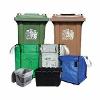What is waste and where does it come from?
Waste is anything that is unwanted or unused and subsequently thrown away, this includes brand new items as well as things used then discarded.
Waste comes from the way we produce and consume goods, often the raw materials are extracted and manufactured to create a product which is then consumed or used for a short period of time until eventually it becomes waste.
This process is often linear, with each phase of production, consumption and disposal causing the release of greenhouse gasses. Currently 14 million tonnes of waste ends up in landfill in the UK, as this breaks down it causes the release of methane which accounts for 27% of total UK methane emissions highlighting the need for waste management.
What is our approach to recycling and waste?
St Helens follows a circular economy approach with the waste produced being collected using a Kerbside sort system to prevent contamination and maximise the amount that can be recycled. Residual waste (brown bin) does not go to landfill but is diverted to an Energy From Waste Facility. The state-of-the-art power plant can generate up to 50 megawatts of electricity - sufficient to power more than 63,000 homes. The steam produced can also be exported to industrial users providing energy as steam rather than electricity which is more efficient. The household waste diverted from landfill is being put to good use and avoiding more than 127,000 tonnes of carbon emissions each year, compared with landfilling.
For more information on Kerbside collections and how to recycle visit St Helens Borough Council Recycling website here: Recycling - St Helens Borough Council
 |  |
Where does our recycling and waste go?
In St Helens waste is collected by the Council and then transferred to a local company who send it to different areas around the UK to be processed:
- Residual waste (brown bin) is sent to an Energy From Waste Facility.
- Food waste travels to Widnes to be repurposed by Refood using an anaerobic digestor, this breaks the food down without oxygen producing biogas used to create biofuel and fertiliser.
- Cans and Steel are processed by St Helens metal Recycling, eventually ending up back on the shelves.
- Plastic is sent to Biffa Waste services in Wigan while cardboard is sent to Sacia in Manchester to be recycled into packaging.
- Paper is sorted by palm paper using a high-tech red wave optical sorter and repurposed into newspapers and magazines.
- Glass is sent to Recresco in Ellesmere Port, where it is sorted, melted, and made into bottles and jars to be used again.
How does this link to Climate Change?
Waste contributes to greenhouse gas emissions in the production, collection, storage and management of products. The methane, carbon dioxide and other greenhouse gases released account for 5% of global emissions equating to 1.6 billion tonnes of carbon dioxide globally.
The circular economy approach in St Helens reduces greenhouse gas emissions entering the atmosphere, therefore reducing the amount of warming and thus the impacts of climate change. By repurposing waste into raw materials and using these in the production process we can reduce emissions by:
- Reduce the waste that goes to landfill or incineration
- Repurposing waste into raw materials which prevents emissions in the extraction of raw materials,
- Using these materials in the production process to reduce carbon emissions.
How can you help?
- Follow the three R's: Reduce, reuse, recycle
- Manage food waste as this produces methane which warms the earth 25x more than carbon dioxide
- Buy responsibly from producers who manage climate change and those local to you to reduce food miles
- Clothes swap - rather than buy new try second hand




